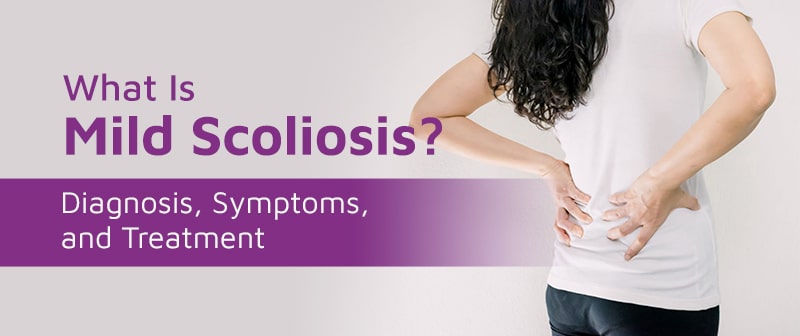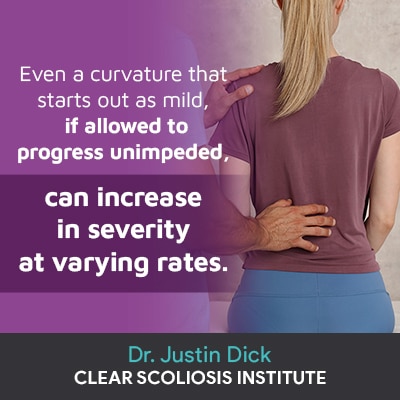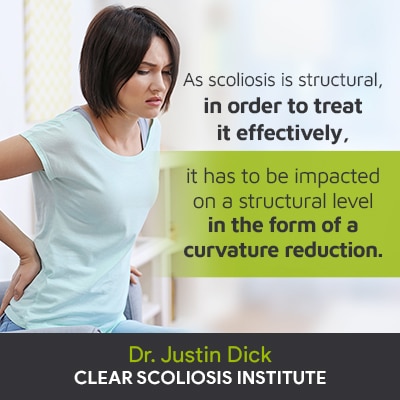
Just as there are different types of scoliosis that can develop, there are also different severity levels; these levels range from mild to severe and are classified based on the size of the abnormal spinal curvature. Symptoms of mild scoliosis are often subtle and don’t commonly cause functional deficits. When it comes to treatment, a proactive approach can work towards keeping the condition mild and preventing further progression.
When scoliosis is diagnosed, the condition is classified based on a number of important patient and condition characteristics, one of which is condition severity. Based on curvature size, a condition is classified as mild, moderate, or severe. Mild scoliosis involves a 10-25 degree curve size.
Let’s start our discussion of mild scoliosis by first touching on the parameters that have to be met to fulfill the definition of scoliosis, and the important patient and condition characteristics that further classify the condition.
For someone to be diagnosed with scoliosis, certain parameters have to be met.
Scoliosis is an abnormal sideways curvature of the spine, but in addition, it must include a rotational element, and the unnatural curve has to be of a minimum size (10 degrees) to be considered scoliosis.
If those parameters are met, the condition is further classified based on patient age, type of scoliosis (cause if known), curvature location, and condition severity.
Condition classification is important not only because it streamlines the treatment process, but also because these important patient and condition characteristics inform the design of treatment plans moving forward.
As mentioned, condition severity is determined by the size of the curvature, and this involves a measurement known as ‘Cobb angle’.
When a patient has scoliosis, their spine is no longer in a healthy and natural alignment. A patient’s Cobb angle tells me how far out of a natural alignment their spine has moved from normal..
Cobb angle is a measurement obtained via X-ray that involves drawing intersecting lines from the tops and bottoms of the curvature’s most-tilted vertebrae (bones of the spine) at the apex of the curvature.
The intersecting lines form an angle that’s measured in degrees and places the condition on its severity scale of mild, moderate, or severe:
Mild scoliosis: Cobb angle measurement of between 10 and 25 degrees
Moderate scoliosis: Cobb angle measurement of between 25 and 40 degrees
Severe scoliosis: Cobb angle measurement of 40+ degrees
While every case is different, which is why it’s so important that treatment plans are fully customized, generally speaking, the higher the Cobb angle, the more severe the condition, and the more likely it is to cause noticeable symptoms like pain (more common in adults) and postural changes.
So now that we know what parameters have to be met in order for a scoliosis diagnosis to be given, along with the important patient and condition characteristics that further classify the condition, what are the symptoms of mild scoliosis?
Symptoms of Mild Scoliosis
As a progressive condition, the nature of scoliosis is to worsen over time, especially if left untreated, or not treated appropriately, which is why proactive treatment is so important.

The most prevalent form of scoliosis is adolescent idiopathic scoliosis (AIS) diagnosed in adolescents between the ages of 10 and 18, which is the type we’ll focus on; this form is at risk for rapid-phase progression due to growth and skeletal maturity.
While we can’t fully predict how fast a patient’s scoliosis will progress, we do know that growth is its number-one trigger, which is why adolescents can experience rapid progression due to the unpredictable growth spurts associated with puberty.
In cases of mild AIS, one of the treatment goals is to be proactive enough that progression can be managed so patients avoid the hardships associated with increasing severity levels.
While every case is different, mild scoliosis symptoms are often just that: mild. In children and adolescents, scoliosis is not commonly painful, and this is also related to growth and skeletal maturity.
In young patients who are still growing and have not yet reached skeletal maturity, their spines are experiencing a constant lengthening motion, and this counteracts the compressive force of the curvature; adults, however, experience scoliosis-related pain more commonly as their spines, and their surrounding muscles and nerves, are vulnerable to compression introduced by the scoliotic curve.
So in the condition’s most prevalent form (AIS), pain is not a common symptom of mild scoliosis, which is one of the main reasons early detection can be a challenge.
The early telltale signs and symptoms of mild scoliosis are postural changes that affect the body’s overall symmetry, but again, as the condition is mild, this means a smaller abnormal curvature, and in many cases, postural changes can be subtle and difficult for anyone, other than an expert, to notice.
While every case produces its own unique symptoms, the most common signs of mild scoliosis include:
In addition, when it’s mild, scoliosis doesn’t commonly cause functional deficits, so particularly in children and adolescents who are also unlikely to feel scoliosis-related pain, early detection isn’t always easy to achieve.
However, as a progressive condition, it’s particularly beneficial to start treatment early on in its progressive line. While there are no treatment guarantees, there are a number of benefits associated with early detection and proactive treatment that increase chances of treatment success.
So if an individual knows the early signs of scoliosis to look for and spotted them, or indicators of the condition were noted in a routine physical, which is quite common, what does treatment involve, and what can it achieve?
If you have recently been diagnosed with mild scoliosis, you might not consider yourself fortunate, but the truth is, the fact that early detection was achieved means you have increased chances of treatment success; however, the advantages of early detection are only available to those who choose a proactive treatment approach, one that believes in working towards a correction while the condition is still mild.
Here at the CLEAR Scoliosis Institute, our certified scoliosis chiropractors do just that. We offer our patients an integrative chiropractic-centered approach that believes in starting treatment as close to the time of diagnosis as possible: while the curvature is still small, flexible, before the body has had time to adjust to its presence, and before significant progression has occurred.
We combine different treatment disciplines to craft the most customized and effective treatment plans possible.
While a traditional approach would recommend monitoring for cases of mild scoliosis, and do little in terms of proactive treatment until conditions progress to a certain point, I believe this is wasting valuable treatment time.
After all, there is no harm in making a small curvature smaller, but there is potential harm in simply observing while a small curve progresses to a larger one unimpeded.
While there are never treatment guarantees and every case is different, generally, our treatment plans involve three main phases: mix, fix, and set.
In the ‘mix’ phase, the focus is on preparing the body for the treatment process with a variety of therapies, such as exercise and massage, that are designed to relax the spine and its surrounding muscles; this makes the spine more responsive to treatment.
The ‘fix’ phase features specialized scoliosis-specific chiropractic adjustments that involve the use of advanced mechanical adjusting instruments applied to the back, hips, and other related areas.
In the final ‘set’ phase, specialized exercises are used to positively impact posture, balance, and coordination. The exercises work by activating certain muscle groups that help provide the spine with support and stabilization.
These exercises also work by targeting specific areas of the brain to alter the brain-body connection to achieve more balanced and natural body positioning.

When treatment for mild scoliosis is successful, we have reduced the abnormal curvature and restored as much of the spine’s healthy curvatures as possible, and we have accomplished this in such a way that the spine’s overall health and function are preserved.
We have also worked towards increasing core strength so the muscles surrounding the spine are better able to support and stabilize it, and ultimately, we have managed the condition to control further progression.
Mild scoliosis is a progressive spinal condition that causes an abnormal sideways spinal curvature, with rotation, and has a Cobb angle measurement of between 10 and 25 degrees.
Mild scoliosis is not associated with overt symptoms, particularly in children and adolescents who don’t commonly experience scoliosis-related pain.
Postural changes it can cause, such as uneven hips and shoulders, can be subtle and difficult for anyone other than a specialist who is trained in how to recognize the condition’s early signs to recognize, which is why early detection isn’t always easy to achieve.
Oftentimes, mild scoliotic curves are detected in routine physicals, and it’s not uncommon for mild scoliosis to go undiagnosed and untreated until it has progressed into maturity and is diagnosed as ‘adolescent scoliosis in the adult’ (ASA).
Here at the CLEAR Scoliosis Institute, we customize each and every treatment plan to address the specifics of important patient and condition characteristics.
Through combining different treatment disciplines such as a variety of therapies, including scoliosis-specific exercise and chiropractic care, we can work towards impacting mild scoliosis on a structural level while the curvature is still small and preventing further progression.
Clear-institute.org - Cobb Angle

CLEAR provides a unique and innovative way of understanding scoliosis. Sign up to receive facts and information you won’t find anywhere else.
